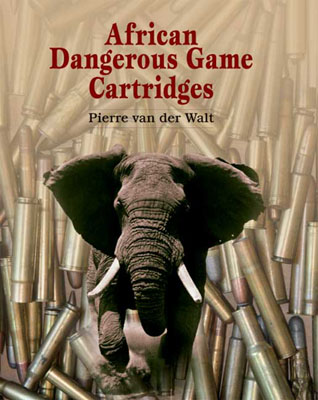|
Book Review: African Dangerous Game Cartridges by Pierre van der Walt By Chuck Hawks  Pierre van der Walt is a renowned South African professional hunter, author and (according to the book's dust jacket) the widest published gun writer in Africa. He is also an advanced level firearms instructor and the founder of South Africa's national gun and hunting show, the Aim & Wild Expo. He has been awarded more honorary life memberships by southern African firearm, hunting and gun rights organizations than any other South African in history. Pierre is known as an avid rifle and cartridge collector, reloader, wildcatter and ballistic experimenter. The point being, he is well qualified to write a definitive reference about contemporary African dangerous game cartridges and this book covers virtually all of them, old and new, that are in use today. African Dangerous Game Cartridges (Pathfinder Book Publishers, ISBN #978-0-620-483391, $85 USD) was commissioned as, "the definitive sequel on the topic for the here and now." Pierre van der Walt has produced a good read that includes much original thought. His book is a great source of information about and reloading data for almost all African dangerous game cartridges, from the 9.3x62 Mauser (of which he is a great fan, as am I) to the .600 Nitro Express. Scattered throughout the book are some gripping photos of African animals, including elephant and lion charges. This is, however, fundamentally a reference work, not a picture book. Here is a list of the chapter titles, to give an idea of the scope of this book and the subjects addressed:
Each chapter is divided into several topical sections, allowing the subject to be explored in considerable detail. Thus, for example, Chapter Two (essential reading for us "gun nuts") delves into Double Rifle Features, Bolt Action Rifle Features, Bolt Action Design Aspects, Common Considerations and a Summary. Chapter Three, "Comfortable Shooting," includes the topical headings: Mass, Recoil, Enough is Enough, Physical Response to Recoil, Recoil Fitness, Historical Rifle Mass and a Comfortable Shooting Mass Formula. (The latter two topics are very important, yet seldom addressed.) In Chapter Three, Pierre has written a detailed and informative analysis of subjective recoil. He is obviously more "recoil fit" than I, since he considers the .460 Weatherby Magnum "quite manageable." He writes that the muzzle brake is the .460's worst enemy and that it changes the noise from, "a roar to a painful thunderclap for everybody, even those around the shooter. The air is not just displaced forward, but in all directions and bystanders physically experience it. Without the muzzle brake it is a far more pleasant cartridge." I heartily agree with this assessment and apply it to muzzle brakes in general. One of the topics I found most interesting was addressed in Chapter Five, the author's classification of bullet impact velocities into three "bands," based on the performance of modern soft point bullets, which the author calls "4th Generation" bullets. The Green Band is most favorable for proper and consistent bullet expansion and extends from 2200-2600 fps. The Amber Band represents minimum impact velocity for at least partial expansion, 2000 fps to 2200 fps, while the Red Band delineates high impact velocity, 2600-3000 fps, where terminal performance becomes increasingly problematic. Pierre uses this classification system throughout the book when discussing bullet performance. Of course, no one is likely to find favor with everything included in a reference such as this. I thought, for example, that when discussing sectional density in Chapter Six the author complicated the subject by bringing in many extraneous factors. (The opposite of the scientific method, which would be to eliminate all variables except the one being considered.) Obviously, terminal velocity, momentum, energy, bullet shape, construction, expansion, target density and so forth influence the bullet's performance and may entirely change the SD of an expanding bullet after impact. However, the salient point about SD, which kind of got lost in the shuffle, is that if all other factors are exactly equal, the bullet with the greater SD should penetrate deeper. I like to think in terms of non-expanding solids of identical shape to keep it simple when discussing SD. SD is one factor and bullet hardness (expansion or lack of same) is another, yet they were combined and intertwined in the discussion in Chapter Six. (Admittedly, they are also intertwined in the field.) You can say this about bullets: if all other factors are equal (including SD!), the harder bullet will penetrate deeper. For example, a .458/500 grain solid, if all other conditions are the same, will penetrate deeper than a .458/500 soft point. That is why they shoot elephants with solids. There are multiple factors involved in bullet penetration and if you examine them individually they are easier (at least for me) to analyze. On the plus side, Pierre touched on practically all of them in Chapters Six and Seven. There are special considerations involved in reloading many African dangerous game cartridges, as many of the cases are larger than normal. The author writes about reloading these cartridges in Chapter Eight, which includes sections on case preparation, annealing, fire forming, pressure signs, accuracy, regulating doubles and so forth. I have not previously encountered such a detailed dissertation on the subject. The author also compiled an extensive powder burning rate chart that includes many powders not usually encountered in North America. Chapters Nine, Ten and Eleven provide information about and reloading data for a great number of African rifle cartridges, many of which are rarely seen elsewhere. As a reader who is interested in rifle cartridges, I spent a lot of time here. By now you should be realizing that the 459 pages comprising African Dangerous Game Cartridges contains a wealth of information and is an absolute must read for anyone considering acquiring a dangerous game rifle. If you have any interest in the subject, buy this book. You will find yourself mining it for information for years to come! |